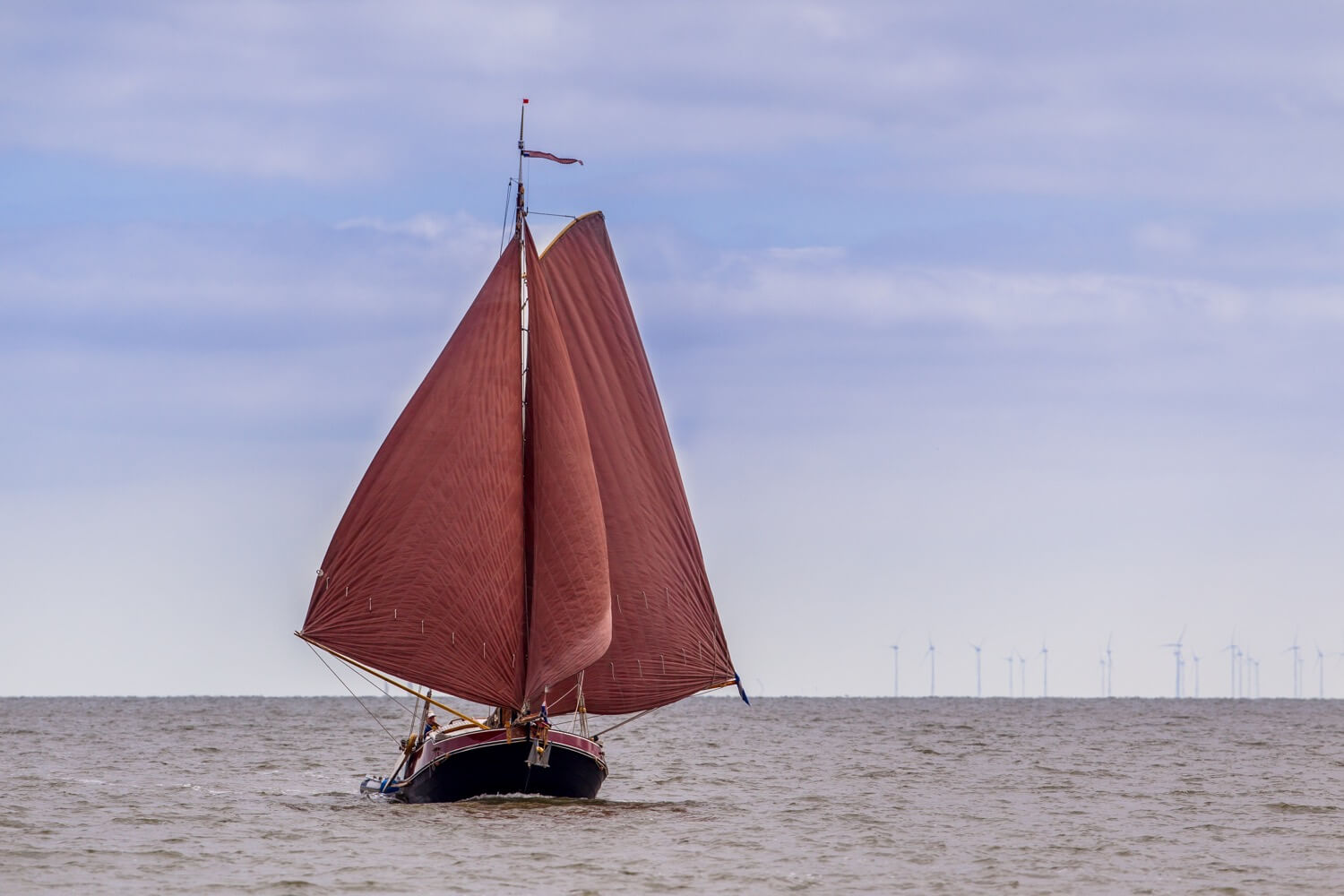12 Surprising Advantages of a Gaff Rig (and Some Cons)
Interested in the gaff rig, but unsure whether it's for you? Trying to pick the right sail rig type can be a challenge. In order to help you out, I made this list of the advantages of the gaff rig.
What are the advantages of a gaff rig? Gaff rigs typically provide more sail area for the same mast length, which results in less stress on the mast and rigging. This allows for a shorter (and therefore stronger) mast and softer and simpler rigging. This results in less hardware, fewer points of failure, and therefore, less maintenance cost.
So why is it the gaff rig has been replaced by the Marconi rig? And does it have any other advantages? Read on for my list with 11 surprising advantages of the gaff rig (and why more people should consider this rig type).

Rectangular Sails Mean Larger Sail Area
Because of the way the gaff rig is set up, it provides more sail area for the same mast length. In other words: you can carry more sailcloth per feet of mast. This is an advantage for a couple of reasons, which I'll go over in detail below. First of all, it reduces the stress on the mast and rigging. This, in turn, results in easier and softer rigging, which can be lighter and easier to operate.
The reason you can carry more sail area is that you carry rectangular sails, thanks to the top spar that attaches from the mast to the top of the sail. That top spar is called the gaff.
The downside of these huge pieces of cloth, however, is that the windward performance of a gaff rig is less optimal than that of a Bermuda sloop. However, you can figure out a way in which a gaff rig outperforms most Bermuda sloops. To understand this, I need to make a quick distinction.
There are two kinds of gaff rigs:
- Authentic gaffers - these boats are from the 1900s and are pretty outdated. They look great, but they are heavy and not set up to sail single-handed.
- Modern gaffers - these boats use the newest technology and are set up in a way that makes sense in the 21st century.
All of the advantages below are largely dependent on the way the boat is fitted. If it's a modern take on the gaff rig, you'll find it has a lot less of the characteristic disadvantages (which you'll find at the end of the article). More 'vintage' rigs will likely have one or more disadvantages compared to the contemporary Bermuda rig. To be fair, so will a Bermuda Sloop from the 1900s. So it's important to keep in mind that we should compare apples to apples and pears to pears.
I have sailed a gaff-rigged Cornish Crabber for a week across the Frisian lakes and they are incredibly easy to operate. But these old boats are slow and tend to be heavy (especially the boom and gaff, which were huge). We were constantly overtaken by modern cruisers. You can't really compare the two.
Now that this is out of the way, let's continue with our list.
Shorter and Much Stronger Mast
Since you can get a disproportionate sail area with the same mast length, many gaff rigs have a shorter mast than their Bermuda cousins. A shorter mast means it will be a lot stronger. You don't lose sail area, but you do lose a lot of extra lengths, cost, and points of failure.
That seems to be the theme of the gaff rig. It's in nearly all ways superior to Marconi (Bermuda) rigs for daysailing and recreational cruising. Unless you're a racer, it's the better option in many ways, Michael Kasten argues on his website.
Lower Center of Gravity
Thanks to the shorter mast, the center of gravity of the gaff rig are lower than that of the Bermuda rig. This helps to reduce heeling, making the gaff rig a bit stiffer.
If you're unsure what all these rigs look like, or what it means, I recommend to read my Illustrated Guide to Rig Types here.
Less Stress on the Mast and Rigging
Thanks to the top spar, the forces on the sail are distributed more evenly. A shorter mast means it's being less stressed and the both the standing and running rigging take a lot less force.
Simpler Rigging
Thanks to the reduced stress on the entire rig, you can fly with much simpler rigging.
You also lose a bunch of additional rigging. For example, you need less sheets, no spreaders, and less hardware to keep your sheets in check. Overall, softer lines and sheets can be used. Not the hard steel cables on Bermuda rigs.
This makes the gaff rig softer to handle, making it a great choice for recreational sailors - as long as you're not constantly beating over the tide.
Especially with the modern take on the gaff rig, a short-gaff configuration, you greatly simplify the rigging needed to operate the main, as well as reduce the total weight of the mast and rigging.
The downside of a simplified rig is that it can potentially be more difficult to sail short-handed. It really depends on the specific boat and the way you set it up. As said, you can fit a gaff rig with all the modern comforts like winches if you want to. If you do, you can set up rig that deals with the gaff rig's cons, while keeping the good parts.
Cheaper
As a result of simplified rigging and a softer set up, the gaff rig can be cheaper than a Bermuda rig. I emphasize can be, because it really depends on your particular set up. Not to get old here, but a vintage boat will be exactly the same as having a vintage car: everything will be (more) expensive.
However, if you opt for a no-nonsense, practical, modern rig, instead of conserving a museum artifact, it can definitely be cheaper, just in terms of the amount of hardware and rigging you'll need to purchase. Let alone maintain.
Low Maintenance
So of course a more simple rig means it is also easier to maintain. Less hardware and rigging means less stuff that's gonna break over time. But what also plays a big part is the 'softer' set up. Everything gets less stressed: your mast, rigging, even the sails themselves. That's where the gaff rig really stands out. It just doesn't age the same way as a Bermuda rig would. It is much less prone to wear and tear. Which means you'll have a lot less maintenance to do.
Less moving parts, less wear, cheaper materials = cheaper and easier.
Looks Gorgeous
The gaff rig is incredibly good-looking. In my opinion, it's the most beautiful rig around. Just look at it:

However, everybody has his or her own preferences, and you don't have to agree with me (although I find that hard to believe).
Easy to Sail
If you can resist the temptation to leave the topsails out of the equation, the gaff rig is really easy to sail. Although people tend to assume gaff rigs aren't meant to be sailed alone, I have, and pretty successfully uneventful.
But I repeat: you should resist the usage of topsails (go bald, as they say). The topsails add a whole lot of work, and the extra pain may outweigh any benefits you get from sailing this rig. Luckily, the solution is pretty simple: just don't fly the topsails.
However, if you get yourself an 'authentic' gaff rig, all of this doesn't really count. Those were built to be operated by small crews of 5-7 people, and they have no winches and rail. So it will be actually more work to sail it by yourself. Modern gaffs will typically fix these issues.
Hoisting the main requires a bit more effort. It's a bit slower to operate, sure, but as there are a lot less moving parts, it's easy to understand and get the hang of it. Which brings me to my next point.
Easy to Learn
The gaff rig is a bit What You See Is What You Get: there are no intricacies and because of the reduced strain on ... everything, it might be a very good starter rig to learn to sail.
Oversheeting is Much Less Problematic
Thanks to reduced strain on the standing rigging and mast, a lower center of gravity (which reduces heel) and the tendency of the gaff to sag to leeward, you could say the rig is a bit safer than the Bermuda rig.
"As the boat heels to a squall, the sagging gaff lets much of the force of the wind escape harmlessly over the top."
Outperforms Bermuda Rig in Most Cases
A small disclaimer: this only goes for modern gaff rigs that are well-built and well-designed. Everything else goes of the table.
While a Bermuda rig has better windward performance, the gaff rig actually performs really well with tides and light winds.
I don't know about you, but I'm not a competitive sailor by any means. I only sail with fair weather. Add to that a little bit of tide - in those circumstances, a gaff rig is probably the better option.
The Bermuda rig is definitely the better choice for speed, maneuverability, and tacking upwind. While I like those characteristics, my life tends to be a lot less cinematic than I like to believe.
"A gaff rigged boat will perform incredibly well, in many cases besting the performance of a high aspect ratio Marconi rigged boat."
- Michael Kasten at KastenMarine.com
Disadvantages
The gaff rig absolutely has disadvantages as well, and I thought it'd be fair to briefly mention the most important ones below.
Windward performance can be subpar
The gaff rig is notorious for louse windward performance, and it's true: the Bermuda rig will outperform the gaff rig - especially on a hard beat to windward. However, it's a small price to pay for the ease of use and simpler maintenance you get in return.
Reefing can be more dangerous with a gaff
You have to remember that you're carrying a large second boom, which is right at head-height when putting in a reef. You don't want to be there when the wind catches it.
Parts for the Marconi Rig may be more readily available
Since Bermuda sloops are so incredibly popular, parts may be more widely available and may be cheaper as well. It's my guess that problem-solving on a gaff rig is easier though, since you can get away with more MacGyver-type solutions.
Using the topsail can be a pain
We touched on this, but I think it's important to mention again, since it can really be a deal-breaker regarding ease of use.
Conclusion
I'm by no means an expert, which is why I have added some great sources to read on, by people who know a lot more about building sailboats than I do. I encourage you to read on and learn more before choosing your next rig.
That being said, there's a lot to be said for the gaff rig. It's beautiful, classic - but it also performs really well if set up correctly. It's not at all obvious that the Marconi rig is superior in all ways. It really depends on your sailing circumstances.
So now you have a great overview of the things to consider when choosing a rig type. If you want to read about other rig types, make sure to check out some of the other articles below.
Did you find the answer to your specific question?
👍 115 👎 8




Comments
dave
Aren’t gaff sails cheaper per m2 to buy. I imagine it is simpler since there is not so much change in camber as there is with a triangular sail?
Geoff
Great breakdown. Many years ago I sailed both gaff and Bermuda rigs and gaff rigs have always held a special spot in my heart. I wonder if you might compare a gaff schooner rig to a ketch? That adds an extra dimension to the comparison.
Nate
Can the gaf be used to hoist cargo on board?
Ned
Some examples of modern Gaffers would be useful - I assumed the Cornish Crabber would be modern rather than old!
Sean
“Cornish Crabbers” is an English company that build a range of trad looking GRP boats up to around 30ft, mostly gaff rigged. The original 24ft Cornish Crabber started life in the 80’s with plywood hulls, but was eventually converted to full GRP hulls.
Details here:
https://www.cornishcrabbers.co.uk
Very nice looking boats but rather cramped and expensive.
Andy B
I have a traditional 24ft gaff cutter that I love and agree with much of what Shawn writes. However one disadvantage he doesn’t mention is the challenge of gybing with running backstays in a fresh wind, especially if single or short-handed. I also would have classed the Cornish Crabber as a modern gaffer. A previous 27ft timber gaffer I owned had alloy spars and a topsail with its own spar, again alloy, and a jackyard. I often set it singlehanded, and found it gave a major performance boost in light to moderate conditions.
Al N
From personal experience, sailing Gaff rigged traditional yachts (without engines) on the Norfolk Broads in UK - i think a real plus point of Gaff over Bermuda [for inland river sailing, through raised riverbanks & trees], is that the centre of effort is higher up, so you can catch more of the available wind….
You also have increased flexibility with how you can set-up the sail, and adjust it’s shape to suit your needs:
By tightening the throat & peak of the gaff, you can flatten the sail to help point further upwind. For lighter airs you can put more curve into the sail by dropping the peak slightly & lifting the end of the boom with the topping lift (or to spill air from strong gusts) On a windy day, if you’re about to drop anchor, pickup a mooring or come alongside a jetty, you can de-power the sail by dropping the peak so the gaff is horizontal (topping lift on) - leaving you with a smaller triangle of effective mainsail from the throat of the gaff to the back of the boom (clew).Leave a comment